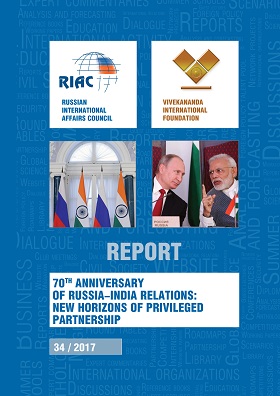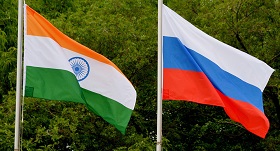Russian (RIAC) and Indian (VIF) experts’ analyses form the basis for this attempt to set a new dynamic for the strategic partnership between the two countries which in 2017 celebrate the 70th Anniversary of diplomatic relations. The multifaceted history of these relations is marked above all by an unprecedented level of trust, mutual understanding, cooperation, mutual assistance and support.
Where do the opinions of Russia and India converge with regard to the role of the United Nations (UN) and international law and its specific elements, such as state sovereignty? What are the reasons for the “colour revolutions”? And where do they happen?
Without a joint understanding of the approaches to the global challenges, setting new cooperation goals mutually pursued by both parties and coming to an agreement on how to overcome the previously outlined horizons of the special and privileged strategic partnership, any discussion about “new horizons” will remain merely beautiful declarations, an exercise in futility.
I would especially like to emphasize the significance of the conclusions and recommendations put forward in the Report, which are grouped concisely around those vectors of Russia–India relations that determine the potential horizons of bilateral ties and cooperation in the short and medium term. As strategic partners, Russia and India cannot move into a new paradigm of cooperation without specific progress in these areas. I am confident that a detailed discussion of this part of the Report will lead to concrete proposals on new mechanisms, without which practical movement in new directions will simply cover old ground; we will be “resting on our laurels” with regard to past achievements in our bilateral relations. It is unlikely that this will satisfy the ambitions of the generation of Russians and Indians that has already entered the political, geopolitical, economic, scientific, technical and other realities of the complex challenges of the XXI century. For this generation, the ability to discern the new and ruthlessly discard the relics of the past and the art of building mutually beneficial relations and pragmatically combining cooperation and competition are the keys in the search for success and a reference point for expanding the horizons of the unique privileged strategic partnership for the hundreds of millions of people living in Russia and India and ready to participate in the construction of a new international security architecture.
Russian (RIAC) and Indian (VIF) experts’ analyses form the basis for this attempt to set a new dynamic for the strategic partnership between the two countries which in 2017 celebrate the 70th Anniversary of diplomatic relations. The multifaceted history of these relations is marked above all by an unprecedented level of trust, mutual understanding, cooperation, mutual assistance and support.
However, the experts’ work is by no means a panegyric to the past. Nor is it yet a road map towards the new horizons of the privileged partnership, although this vector is organically integrated into the title of the Report marking the 70th Anniversary of Russia–India ties. The main emphasis of the Report is concentrated in the first paragraph of the Conclusions and Recommendations section, specifically: “India is Russia’s long-standing and reliable partner. However, the current model of ties has largely exhausted itself, and cooperation should be taken to a qualitatively new level.”
The authors are not as unequivocal in their assessments of where Russia and India stand in the turbulent flow of the restructuring of international relations from the bipolarity of the Cold War to the polycentric nature of the future international security architecture that is still maturing and yet to be understood. How do the two countries define their places and their roles in the dialectics of simultaneous globalisation and regionalisation of international relations? What do the terms “non-aligned state” and “third world” country really mean with regard to India and also Russia? The US society is divided like never before: with the country giving up significant ground in terms of its unconditional and universal dominance and its increased efforts to compete with China, it is possible that a new bipolarity could emerge – the United States against China, with Russia and India being the new “non-aligned” powers relying on regional systems of international security such as BRICS, the Shanghai Cooperation Organisation (SCO), the Association of Southeast Asian Nations (ASEAN), the Eurasian Economic Union (EAEU) and the Collective Security Treaty Organisation (CSTO). All the more so because the new threats and challenges of the XXI century, above all international terrorism, do not tend to dampen their anti-human activity.
Where do the opinions of Russia and India converge with regard to the role of the United Nations (UN) and international law and its specific elements, such as state sovereignty? What are the reasons for the “colour revolutions”? And where do they happen?
Without a joint understanding of the approaches to the global challenges, setting new cooperation goals mutually pursued by both parties and coming to an agreement on how to overcome the previously outlined horizons of the special and privileged strategic partnership, any discussion about “new horizons” will remain merely beautiful declarations, an exercise in futility.
What is more, it has unfortunately become commonplace over the past quarter of a century to view each other through the eyes of western “interpreters” of events both in Russia and in India, which serves only to distort each other’s motives in the international arena. As a result, Russia is charged with almost “fraternizing” the Taliban or forming an alliance with the Pakistan military, whose questionable “successes” are only in the longstanding suppression of its own country’s democratic forces and institutions. The authors should not succumb to the temptation of being too focused on the desire to “make Russia–India relations independent of their ties with third countries and impervious to crises and changes in global circumstances.” We can only welcome those experts who are not trying to build a fence around bilateral Russia–India relations or make taboo the sovereign right to act in accordance with the national security interests in any given international political climate and attract the support of modern multilateral “non-western” institutions such as the SCO and BRICS, openly and profoundly explaining the motives both for the steps already taken and for planned actions to their “tried and tested privileged strategic partner.”
Unfortunately, the expert community did not recommend that the Indian leadership attend the Belt and Road Forum in Beijing in May 2017. Where else but at the Forum could Russia, India, Iran and even Afghanistan discuss the need to build an International Transport Corridor (ITC) as part of the Belt and Road without allowing the massive infrastructural mega-project to profit only one party ? There is no doubt that a broad discussion on the subject would have included Central Asian states.
The authors also deserve credit for not getting carried away with the decades-old and pleasing-to-the-ears mantra “Hindi Russi bhai bhai,” for not getting caught up in the nostalgia of the 70-year history of Russia and India’s unique bilateral relations. What is more, the authors are very convincing in their critical assessments of traditional mechanisms, full as they are of red tape and the rot of corruption.
I feel compelled to quote a fundamentally important position expounded in the introduction to the Report, as it is precisely here that the prism through which the majority of the expert contributors present their views for the future is put forward: “… to achieve substantial progress in bilateral relations it is necessary to renew their strategic paradigm. Working on a range of cooperation projects that meet the new economic needs of Russia and India will make a qualitative leap in economic ties [which, however vulnerable, form the cornerstone of bilateral cooperation – VT] possible. Joint initiatives should be based on the global competitive edge of both countries and transition to new development models. The cooperation mechanisms must be revised to adapt to new realities.”
It is also important to note in the Report the parts that will inevitably move into a new strategic paradigm in the form of concretising India’s goals “Make in India,” “Skilling India,” “Act East” and Russia’s “Turn to the East”, etc. The time to think in large and specific categories is fast approaching. So why do we need individual private projects in aircraft construction when the mutual experience that both countries have already accumulated is sufficient to create a joint aerospace holding? Why not switch from building naval ships for India on a contractual basis to using ice-free waters of the Indian Ocean somewhere in the vicinity of Visakhapatnam or Kochi to set up a joint shipyard enterprise or deep-sea port that can also be used to build ships for third countries? Indian steel production combined with Russian technologies has great potential in terms of designing and manufacturing oil and gas platforms on the continental shelf, including the Arctic.
You do not need to be any kind of special visionary to understand the inevitable rise in global food consumption, the exacerbation of the problem of chemical fertilizers, the dwindling fresh water reserves and the necessity to disinfect products. All these topics are parts of the new paradigm of strategic partner relations between Russia and India. The SCO and BRICS frameworks are large enough to attract China, Pakistan, Afghanistan, Iran and other countries in the Indo-Pacific region to Russia–India bilateral relations in these large-scale projects.
In Russia, the task of building a digital economy as a radical innovative breakthrough is becoming ever more urgent. Experts rightly point out both the prospects and the difficulties of the hi-tech component of Russia–India cooperation. But even here there is great largely untapped potential of India as a global leader in software exports, and Russia is recognised as a kind of “breeding ground” for the best computer programmers in the world. There is a common space for mutually beneficial cooperation.
I would especially like to emphasize the significance of the conclusions and recommendations put forward in the Report, which are grouped concisely around those vectors of Russia–India relations that determine the potential horizons of bilateral ties and cooperation in the short and medium term. As strategic partners, Russia and India cannot move into a new paradigm of cooperation without specific progress in these areas. I am confident that a detailed discussion of this part of the Report will lead to concrete proposals on new mechanisms, without which practical movement in new directions will simply cover old ground; we will be “resting on our laurels” with regard to past achievements in our bilateral relations. It is unlikely that this will satisfy the ambitions of the generation of Russians and Indians that has already entered the political, geopolitical, economic, scientific, technical and other realities of the complex challenges of the XXI century. For this generation, the ability to discern the new and ruthlessly discard the relics of the past and the art of building mutually beneficial relations and pragmatically combining cooperation and competition are the keys in the search for success and a reference point for expanding the horizons of the unique privileged strategic partnership for the hundreds of millions of people living in Russia and India and ready to participate in the construction of a new international security architecture.
I would like to believe that readers of the Foreword would agree with the author’s intention to refrain from an assessment of each position of this very fundamental work by Russian and Indian experts but only to risk prompting participants in the discussion of the Report to set aside any taboos they may have with regard to critical views on the present and future of these two great Eurasian nations which intend to continue to stand shoulder to shoulder for the benefit of universal peace and security.
Moscow, October 2017.







